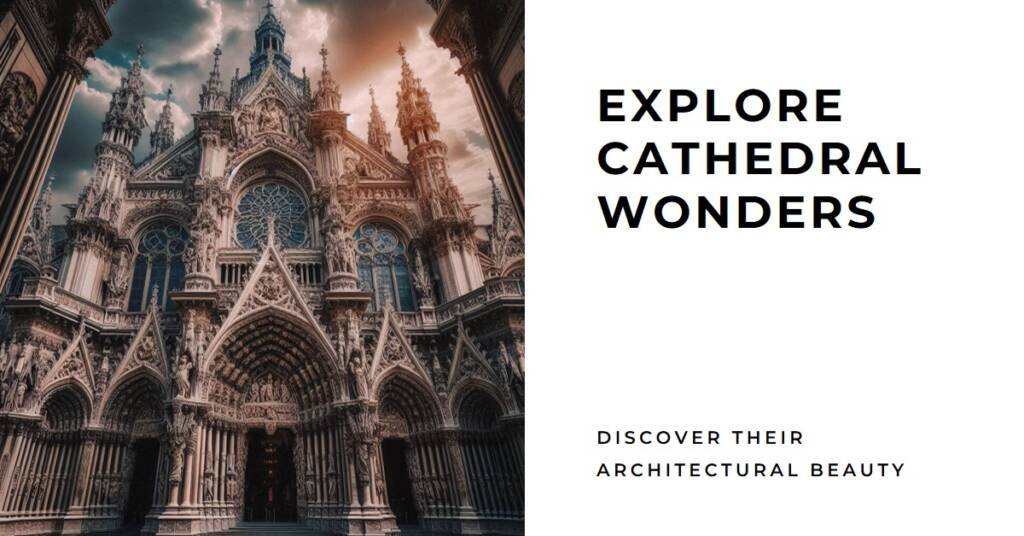
Table of Contents
- Introduction to Cathedrals
- Historical Significance of Cathedrals
- Architectural Styles of Cathedrals
- Notable Cathedrals Around the World
- Symbolism in Cathedral Architecture
- Cathedrals as Centers of Art and Culture
- Sustainability and Preservation of Cathedrals
- Modern Interpretations of Cathedral Architecture
- Conclusion: The Enduring Legacy of Cathedrals
Introduction to Cathedrals
Cathedrals are grand religious structures that serve as central places of worship for Christian communities, typically serving as the seat of a bishop. Their architectural designs reflect a rich historical context, evolving from the early Christian basilicas established in the 4th century to the sophisticated Gothic cathedrals that came to epitomize medieval Europe. Initially, these early basilicas were relatively simple in their design, often featuring a rectangular layout with a wooden roof. As Christianity spread throughout the Roman Empire, so did the architectural sophistication of these sacred buildings.
The evolution of cathedrals marked significant cultural shifts throughout history, reflecting not only the religious aspirations of the communities that built them but also their social and political contexts. The transition from basilicas to more complex designs in the Middle Ages introduced features such as flying buttresses, pointed arches, and ribbed vaults that would come to define the Gothic style. This architectural transformation not only demonstrated advanced engineering techniques but also shifted the aesthetic focus from the horizontal, calm lines of Roman architecture to vertical structures that reached for the heavens, symbolizing divine aspiration.
Cathedrals have played an essential role in society. They function as places of worship and community gathering, serving various social and educational purposes. The artwork contained within them, from stained glass windows to intricate sculptures, acts as a narrative tool, conveying scriptural stories and moral lessons to believers and visitors alike. As architectural masterpieces, cathedrals bear witness to the artistry and craftsmanship of their time, showcasing the cultural identity and historical significance of the regions in which they were constructed. Their monumental presence continues to inspire awe and reverence, proving that cathedrals are not merely buildings, but enduring symbols of faith and human creativity.
Historical Significance of Cathedrals
Cathedrals have long served not just as places of worship, but also as significant landmarks that embody the cultural, social, and political dynamics of their time. These monumental structures often acted as focal points for communities, where individuals gathered for religious services and ceremonies. The architectural grandeur and spiritual symbolism of cathedrals frequently reflected the prosperity and values of the society they represented, making them a physical manifestation of the prevailing ideologies and power structures.
Moreover, cathedrals played a crucial role in the assertion of ecclesiastical authority, influencing not only religious but also secular governance. In many instances, the construction of a cathedral was an undertaking that required significant resources, thereby allowing clergy and church leaders to exhibit wealth and power. The resulting edifices were, and often still are, seen as symbols of divine presence on earth, emphasizing the relationship between God and the community. This connection reinforced the church’s importance in daily life and governance, shaping the political landscape of various eras.
Beyond their function as religious structures, cathedrals serve as historical records encapsulating the artistry of different epochs. Their architectural styles, from Gothic to Baroque, reveal the evolution of construction techniques and aesthetic preferences across the ages. Ornate sculptures, stained glass, and frescoes found within these buildings tell stories of theological narratives and historical events, offering insight into the societal values during the periods in which they were created. The preservation of these structures allows for an educational exploration of history through the lens of architecture and art, fostering a deeper understanding of the epochs and cultures that shaped them.
Architectural Styles of Cathedrals
Cathedrals around the globe showcase a wide array of architectural styles, each reflecting the cultural, religious, and historical contexts of the periods in which they were constructed. Among the most prominent styles are Romanesque, Gothic, Baroque, and modern approaches, each characterized by distinct elements and features that mark their uniqueness.
The Romanesque style, prevalent between the 9th and 12th centuries, is characterized by its thick walls, round arches, and sturdy pillars. This style aimed to convey stability and strength, often incorporating intricate stone carvings and minimal windows, creating a dimly lit but profoundly serene atmosphere. Notable examples include the Abbey of Saint-Germain-des-Prés in Paris, emblematic of this style’s robust and monumental design.
In contrast, the Gothic style emerged in the 12th century and continued into the 16th century, marked by advancements in structural engineering. Its hallmark features include pointed arches, ribbed vaults, and flying buttresses, allowing for taller structures filled with large stained glass windows that filled interiors with natural light. The Notre-Dame Cathedral in Paris and the Chartres Cathedral exemplify the resplendent beauty and verticality characteristic of Gothic architecture, symbolizing a move towards expressiveness in design.
The Baroque period, emerging in the late 16th century, favored grandeur and drama, utilizing rich decoration and dynamic forms. Cathedrals of this era often feature elaborate façades, intricate sculptures, and expansive interiors that seem to transcend spatial boundaries. St. Peter’s Basilica in Vatican City is a prime example, representing the culmination of Baroque ideals where architecture becomes a theatrical experience.
Modern cathedral architecture has sought to integrate contemporary design with traditional elements. Utilizing innovative materials and construction techniques, these structures often emphasize simplicity and functionality. Examples such as the Cathedral of Our Lady of the Angels in Los Angeles illustrate how modernist influences can create spiritual spaces that resonate with contemporary worshippers while retaining an air of reverence.
Notable Cathedrals Around the World
Throughout history, cathedrals have stood as monumental testaments to faith, artistry, and cultural identity. Some of the most notable cathedrals globally are significant not just for their religious importance, but also for their extraordinary architectural designs and historical narratives. One prime example is the Notre-Dame de Paris, an iconic structure of French Gothic architecture. Completed in the 14th century, Notre-Dame features a unique combination of sculptures, flying buttresses, and large rose windows. Its recent restoration following the devastating fire in 2019 further emphasizes the enduring impact of this masterpiece on both local communities and the world at large.
St. Peter’s Basilica in Vatican City exemplifies the height of Renaissance architecture. Originally designed by Bramante, then enhanced by Michelangelo, St. Peter’s stands as a sublime expression of Baroque design with its grand dome, opulent interiors, and intricately detailed facades. As a major pilgrimage site, it plays a central role in the Catholic Church and represents the artistic achievements of the period. The scale of its architecture not only inspires awe in visitors but also reflects the spiritual profundity associated with such significant religious sites.
The Cathedral of Seville in Spain is celebrated both for its monumental size and unique history, being the largest Gothic cathedral in the world. Originating in the 15th century on the site of a mosque, it showcases a harmonious blend of Gothic and Mudéjar architectural styles. Features such as the impressive Giralda tower and the stunning altarpiece reveal a rich artistic heritage that captivates thousands of visitors annually. Each cathedral serves as a focal point for local communities, embodying cultural continuity and faith. These architectural masterpieces reflect the diverse histories and artistry of the societies that built them, making them significant landmarks in the world of architecture.
Symbolism in Cathedral Architecture
Cathedrals are not merely architectural feats; they serve as profound symbols of faith and spirituality. Various symbolic elements are interwoven into their designs, often reflecting the theological and cultural significance of the communities that built them. One of the primary aspects of cathedral architecture is the use of light, which plays a critical role in creating a spiritual atmosphere. Large, stained glass windows allow natural light to filter into the interior, casting colorful patterns that evoke a sense of the divine. This use of light symbolizes both enlightenment and the presence of the sacred, suggesting that the divine illuminates the path of believers.
Another recurrent theme in cathedral architecture is the motif of ascension. Structures are often designed with towering spires and vertical lines that draw the eye upwards, symbolizing the connection between the earthly realm and the heavens. These ascending elements encourage visitors to reflect on their spiritual aspirations and the journey towards transcendence. Such architectural choices remind congregants of the importance of striving for a higher purpose and the eternal nature of the soul.
Sacred geometry also plays a significant role in enhancing the symbolism found within cathedrals. The proportions and layouts often adhere to geometric principles that signify harmony and balance, further reinforcing the spiritual ambiance. Patterns such as the use of circles and squares are intentionally designed to evoke a sense of unity with the cosmos and divine order. When visitors engage with these geometric elements, they are subliminally reminded of the mathematical precision inherent in the universe, which many religious teachings equate to God’s design.
Overall, the symbolism embedded in cathedral architecture serves as a vital conduit for spiritual experience, effectively illustrating religious themes and beliefs. By integrating light, ascension motifs, and sacred geometry, cathedrals invite individuals to explore their faith on deeper levels and reflect on the mysteries of existence.
Cathedrals as Centers of Art and Culture
Cathedrals have long served as pivotal centers of art and culture, acting as both places of worship and repositories of creative expression. Throughout history, these magnificent structures have housed numerous works of art, ranging from intricate stained glass windows to stunning sculptures and frescoes, which reflect the spiritual aspirations and cultural values of the communities they serve. The architectural design of cathedrals often incorporates these artistic elements, allowing them to harmonize seamlessly with the overall structure and aesthetic vision.
The elaborate stained glass windows found in cathedrals represent a hallmark of this artistic synergy. They not only illuminate the religious narratives depicted within their colorful panels but also serve as examples of remarkable craftsmanship. The use of light plays a crucial role in enhancing the experience of those who enter these sacred spaces, creating a sense of transcendence that is deeply connected to the divine. Artists and artisans, often commissioned by the church or community, dedicated their skills to these projects, resulting in artworks that stand the test of time.
Sculptures found within cathedrals further encapsulate the artistic prowess of different eras. From gargoyles that serve both decorative and functional purposes to detailed reliefs and life-sized figures, these works of art contribute significantly to the narrative and symbolic language of cathedrals. They are not simply adornments; they play a vital role in conveying theological concepts and community identity.
The embrace of artistic expression within cathedrals has supported countless artists throughout history, fostering communities of creativity that transcend generations. Today, these magnificent structures continue to inspire contemporary artists, offering a blend of historical reverence and modern artistic exploration. As cultural landmarks, cathedrals remain crucial in understanding the evolution of art aligned with religious and communal life, thus securing their legacy as centers of art and culture.
Sustainability and Preservation of Cathedrals
As globally significant structures, cathedrals represent not only remarkable architectural achievements but also invaluable cultural heritage. However, they face numerous challenges regarding preservation in the context of modern environmental concerns. The sustainability of these monumental edifices has become increasingly relevant as they contend with the effects of climate change, pollution, and the demands of contemporary society.
Conservation efforts play a crucial role in maintaining the structural integrity and historical significance of cathedrals. These actions often involve repairing damage caused by natural elements and human activity, while also ensuring that restoration methods align with preservation standards. Skilled artisans and conservators utilize traditional materials and techniques to retain the original character of the buildings, which is essential for future generations. Moreover, established conservation guidelines advocate for a balance between restoring the physical structure and respecting the cultural narratives associated with these sacred spaces.
In addition to traditional preservation methods, the integration of sustainable practices has emerged as a focal point in the maintenance of cathedrals. Implementing eco-friendly solutions, such as energy-efficient lighting and water conservation systems, can significantly reduce the environmental impact of these historical sites. The use of modern technology also offers innovative opportunities for preservation; for instance, 3D modeling and digital imaging allow for detailed assessments of structural conditions, while drone surveys can identify areas requiring attention that might be difficult to access otherwise.
Collaboration between architects, conservationists, and the community is essential for ensuring that cathedrals remain not only relevant but also sustainable. By fostering awareness and promoting responsible stewardship, we can enhance the preservation of these architectural masterpieces, ensuring their survival for future generations. Ultimately, the ongoing commitment to sustainability in cathedral preservation stands as a testament to the value we place on our shared cultural heritage.
Modern Interpretations of Cathedral Architecture
The influence of traditional cathedral design can be observed in contemporary architecture as architects seek to redefine spiritual spaces while adhering to modern aesthetic principles. Contemporary cathedrals often reflect a tension between honoring historical precedents and embracing innovative techniques and materials. This evolution manifests in various forms, from minimalist designs to the integration of technology in construction and functionality.
One of the hallmarks of modern cathedral architecture is the use of sustainable materials and eco-friendly designs. Architects today prioritize energy efficiency and the environmental impact of their structures, responding to global concerns about climate change. A notable example is the Cathedral of Our Lady of the Angels in Los Angeles, which incorporates sustainable practices while maintaining a grand sense of space, embodying both ecumenical values and modernity.
Moreover, the rise of parametric design and digital fabrication has enabled architects to experiment with intricate forms that challenge traditional cathedral layouts. This has resulted in spaces that not only serve a religious function but also invite community engagement and interaction. The Christ Cathedral in California showcases this trend, utilizing glass elements to create a feeling of openness and transparency, inviting the outside world into its sacred space.
In balancing tradition and innovation, modern cathedrals often draw inspiration from historical architectural styles. Elements such as vaulted ceilings, stained glass, and grandeur are reimagined in contemporary contexts, bridging the past with the present. This dialogue between old and new is crucial in creating spaces that resonate with diverse religious and cultural communities.
As cities continue to evolve, the role of cathedrals adapts alongside them. Contemporary interpretations of cathedral architecture serve not only as places of worship but also as iconic landmarks, reflecting the values and aspirations of modern society while paying homage to their rich historical lineage. Ultimately, the ongoing transformation of cathedral design encapsulates a broader narrative about the future of sacred architecture in a dynamic world.


Conclusion: The Enduring Legacy of Cathedrals
Cathedrals around the globe stand as monumental testaments to human ingenuity, faith, and perseverance. Their architectural significance transcends mere construction; these structures symbolize the evolution of artistic expression and community values throughout history. Cathedrals were not only centers for worship but also communal hubs that fostered social cohesion, cultural exchange, and regional identity. From the intricate Gothic spires of Notre-Dame in Paris to the majestic domes of St. Peter’s Basilica in Vatican City, each cathedral represents a unique narrative interwoven with the architectural style of its time.
The enduring legacy of cathedrals can be observed in their influence on modern architecture. Many contemporary architects draw inspiration from these ecclesiastical edifices, incorporating elements of grandeur, symmetry, and intricate detail into their designs. The reverberations of cathedrals are evident in various settings, from public buildings to private residences, highlighting their role as archetypes of aesthetic and functional excellence. Furthermore, the preservation efforts surrounding ancient cathedrals underscore their cultural importance, as they serve not only as historical landmarks but also as custodians of collective memory.
Moreover, cathedrals have been pivotal in shaping the spiritual landscape, influencing theological thought and community practices across epochs. They foster atmospheres of reflection and reverence, inviting individuals to engage with the transcendent. Their architectural brilliance, coupled with rich histories, creates an environment in which people from diverse backgrounds can connect not only to the divine but also to one another.
In conclusion, the architectural significance of cathedrals endures through time as powerful symbols of human creativity and spirituality. They remind us of our shared heritage and continue to inspire awe and reverence, ensuring their place as cornerstones of both architectural history and cultural identity.



